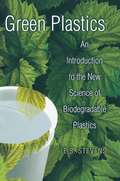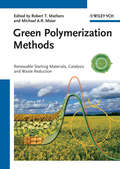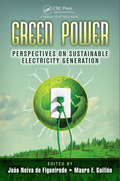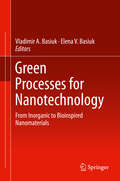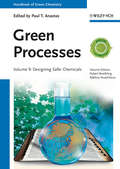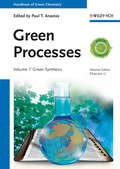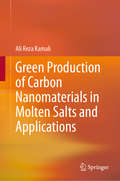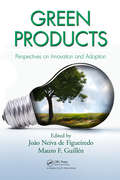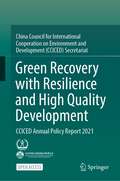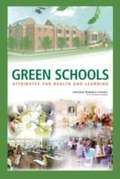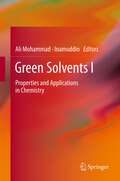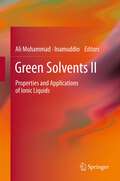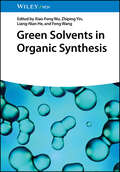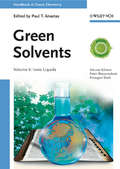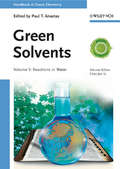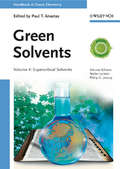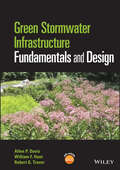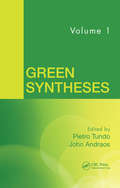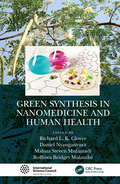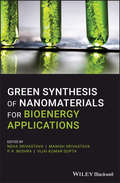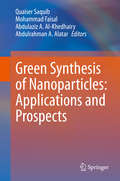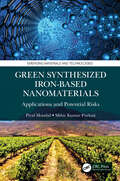- Table View
- List View
Green Plastics: An Introduction to the New Science of Biodegradable Plastics
by E. S. StevensPlastics are everywhere. Bags, bank cards, bottles, and even boats can all be made of this celebrated but much-maligned material. Yet most of us know next to nothing about plastics. We do know that they are practical and cheap--but they also represent a huge environmental problem, for they literally take ages to decompose. In this engaging book, E.S. Stevens tells us everything we have always wondered about plastics and of the efforts, in America, Europe, and Asia, to develop a new breed of environmentally friendly plastics. He points to a possible future where plastics will no longer be made of petroleum, but of plants. The first two chapters assess the increased use of plastics as a relatively new alternative to other materials. The third chapter introduces us to their impact on the environment and strategies for their disposal or recycling. The next two chapters cover basic concepts and terms used in polymer sciences and provide some basic chemistry. With these fundamentals in tow, the author compares how petroleum-based and biological polymers are made, and the various ways in which they decompose. He acquaints readers with the emerging technologies, their commercial viability, and their future. Finally, instructions are given for preparing basic bioplastics using readily available materials. Nonspecialists will find Green Plastics a concise introduction to this exciting interdisciplinary topic--an introduction otherwise not available. For students it provides easy entry to an area of science with wide appeal and current importance; for teachers, excellent background reading for courses in various sciences. The prospect of depleted fossil fuel supplies, and the potential benefits of bioplastics to the environment and to rural areas that could supply the raw materials, make this book a compelling presentation of a subject whose time has come.
Green Polymerization Methods: Renewable Starting Materials, Catalysis and Waste Reduction
by Robert T. Mathers Michael A. R. MeierDesigning polymers and developing polymerization processes that are safe, prevent pollution, and are more efficient in the use of materials and engergy is an important topic in modern chemistry. Today, green polymer research can be seen increasingly in academia nd industry. It tackles all aspects of polymers and polymerization - everything from chemical feedstocks, synthetic pathways, and reaction media to the nature of the final polymer as related to its inherent nontoxicity or degradability. This book summarizes and evaluates the latest developments in green polymerization methods. Specifically, new catalytic methods and processes which incorporate renewable resources will be discussed by leading experts in the field of polymer chemistry. This book is a must-have for Polymer Chemists, Chemists Working with/on Organometallics, Biochemists, Physical Chemists, Chemical Engineers, Biotechnologists, Materials Scientists, and Catalytic Chemists.
Green Power: Perspectives on Sustainable Electricity Generation
by Mauro F. Guillén João Neiva de FigueiredoGreen Power: Perspectives on Sustainable Electricity Generation provides a systematic overview of the current state of green power and renewable electrical energy production in the world. Presenting eight in-depth case studies of green power production and dissemination, it illustrates the experiences and best practices of various countries on this
Green Processes for Nanotechnology
by Vladimir A. Basiuk Elena V. BasiukThis book provides the state-of-the-art survey of green techniques in preparation of different classes of nanomaterials, with an emphasis on the use of renewable sources. Key topics covered include fabrication of nanomaterials using green techniques as well as their properties and applications, the use of renewable sources to obtain nanomaterials of different classes, from simple metal and metal oxide nanoparticles to complex bioinspired nanomaterials, economic contributions of nanotechnology to green and sustainable growth, and more. This is an ideal book for students, lecturers, researchers and engineers dealing with versatile (mainly chemical, biological, and medical) aspects of nanotechnology, including fabrication of nanomaterials using green techniques and their properties and applications.
Green Processes: Designing Safer Chemicals (Handbook of Green Chemistry)
by Paul T. Anastas Robert Boethling Adelina Voutchkova-KostalThe shift towards being as environmentally-friendly as possible has resulted in the need for this important reference on the topic of designing safer chemicals. Edited by the leading international experts in the field, this volume covers such topics as toxicity, reducing hazards and biochemical pesticides. An essential resource for anyone wishing to gain an understanding of the world of green chemistry, as well as for chemists, environmental agencies and chemical engineers.
Green Processes: Green Synthesis (Handbook of Green Chemistry)
by Paul T. Anastas Chao-Jun LiEdited by Professor CJ Li, one of the leading international experts in the fields of Green Chemistry and Green Synthesis, this volume presents such hot topics as synthesis without protecting groups, multi-component reactions, and synthesis in green solvents. The Handbook of Green Chemistry comprises of 9 volumes in total, split into 3 subject-specific sets. The three sets are available individually. All 9 volumes are available individually, too. Set I: Green Catalysis - Volume 1: Homogeneous Catalysis - Volume 2: Heterogeneous Catalysis - Volume 3: Biocatalysis Set II: Green Solvents - Volume 4: Supercritical Solvents - Volume 5: Reactions in Water - Volume 6: Ionic Liquids Set III: Green Processes - Volume 7: Green Synthesis - Volume 8: Green Nanoscience - Volume 9: Designing Safer Chemicals The Handbook of Green Chemistry is also available as Online Edition. Podcasts Listen to two podcasts in which Professor Paul Anastas and Journals Editor Paul Trevorrow discuss the origin and expansion of Green Chemistry and give an overview of The Handbook of Green Chemistry.
Green Production of Carbon Nanomaterials in Molten Salts and Applications
by Ali Reza KamaliThis book focuses on the possible interactions that might occur between carbon materials and molten salts, and discusses the mechanisms involved in detail, highlighting possible future developments in the field. Carbon materials can be exposed to molten salts in various technologically important applications, such as in molten salt-nuclear reactors and aluminum production electrolysis cells. As such, numerous studies have investigated the possible interactions between carbon and molten salts. In addition, various interesting carbon nanostructures have recently been produced in molten salts, including carbon nanotubes, graphene and nanodiamonds with a number of attractive applications. With abundant images and graphs supporting the discussion, this book appeals to researchers working in the field of carbon nanostructures, carbon capture and conversion, nuclear reactors, energy storage, molten salts and related areas of science and technology.
Green Products: Perspectives on Innovation and Adoption
by Mauro F. Guillén João Neiva de FigueiredoSharing successful examples of sustainable products from around the world, Green Products: Perspectives on Innovation and Adoption supplies an in-depth analysis of the key factors that influence the adoption of sustainable products. It examines case studies of green production and consumption from a business perspective considering both techno
Green Protein Processing Technologies from Plants: Novel Extraction and Purification Methods for Product Development
by Alan Javier Hernández-Álvarez Martin Mondor Matthew G. NosworthyThis edited book provides the first comprehensive overview on conventional and emerging processing technologies for the extraction and purification of proteins and/or peptides from plant sources with a special focus on subsequent product development.The book opens with an introduction to the most conventional processing technologies used in industry today: the alkaline extraction followed by isoelectric precipitation, and air classification. The book also focusses on novel extraction and purification technologies, covering the most recent green emerging technologies based on enzymatic processes, solvents, high-pressure processing, barometric membrane technologies, and microwave-assisted extraction, among others. The final chapters bridge the gap between the presented methods and product development and highlight how these technologies can alter protein functionality and nutritional quality of the extracted protein, and thereby, impact human health.In the context of rising consumer interest in foods from plant-protein ingredients and the United Nations targets for Sustainable Development Goal 12 on ‘Responsible Consumption and Production’, this book will provide an indispensable resource for students, engineers and researchers in academia and industry, working in the area of food science, food technology and plant-based product development.
Green Recovery with Resilience and High Quality Development: CCICED Annual Policy Report 2021
by CCICEDThis open access book is based on the research outputs of China Council for International Cooperation on Environment and Development (CCICED) in 2021. It covers major topics of Chinese and international attention regarding green development, such as climate, biodiversity, ocean, BRI, urbanization, sustainable production and consumption, technology, finance, value chain, and related topics. It also reviews the progress of China‘s environmental and development policies and the impacts from CCICED. This is a highly informative and carefully presented book, providing insight for policy makers in environmental issues.
Green Scenarios: International Mining Forum 2021
by Artur DyczkoThis book aims to present an alternative based on natural processes and an environmental approach to post-excavation site management, e.g., post-coal mining heaps. These sites are places where various mineral excavation by-products are collected. Nevertheless, some post-mineral excavation sites are oligotrophic, terrestrial, wetland, and water habitat islands, providing unique biodiversity enrichment in the landscape. These oligotrophic mineral habitats are essential in over-fertilized, eutrophic, agricultural and urban-industry surroundings. Some post-mineral excavation sites are places where the wildlife can develop and support the functional processes of novel ecosystems. Implementing the newest biogeochemical and comprehensive knowledge into urban-industry landscape management will help to establish the ecosystem’s processes and environmental functioning.There are several post-industrial sites in Europe where the wildlife areas developed due to natural processes, are becoming wildlife hotspots in densely populated urban-industry areas. In this respect, many of the oligotrophic mineral terrestrial, wetland, and water habitats of anthropogenic origin should not be categorized as environmentally dangerous and undergo economic utility-focused reclamation.Facing the actual environmental constraints of the Anthropocene Epoch, the book’s chapters presenting the natural basics and perquisites of the environmental ecosystem mosaics, will be interesting for a broad range of environmentalists (scientists and students), miners, economists, and sociologists.
Green Schools: Attributes For Health And Learning
by National Research Council of the National AcademiesEvidence has accumulated that shows that the quality of indoor environments can affect the health and productivity of adults and children. One consequence is that a movement has emerged to promote the design of schools that have fewer adverse environmental effects. To examine the potential of such design for improving education, several private organizations asked the NRC to review and assess the health and productivity benefits of green schools. This report provides an analysis of the complexity of making such a determination; and an assessment of the potential human health and performance benefits of improvements in the building envelope, indoor air quality, lighting, and acoustical quality. The report also presents an assessment of the overall building condition and student achievement, and offers an analysis of and recommendations for planning and maintaining green schools including research considerations.
Green Science and Technology
by Enoch Y. Park Takayuki Saito Hirokazu Kawagishi Masakazu HaraThis book provides a comprehensive and up-to-date review of recent trends of green science and technology. Worldwide deterioration of environment and global warming threaten our lifestyle and the survival of all creatures. In order to weather these problems, we need to construct a multidisciplinary approach involving the fusion of various advanced researches. The book begins with an overview on fundamental research about generation and utilization of renewable energy, protection of the earth's ecosystem for better coexistence with nature, development of artificial intelligence-based agriculture and molecular recognitionbased welfare and covers a wide range of innovative research on green science and technology.
Green Solvents I
by Ali Mohammad Inamuddin Dr.The conventional solvents used in chemical, pharmaceutical, biomedical and separation processes represent a great challenge to green chemistry because of their toxicity and flammability. Since the beginning of "the 12 Principles of Green Chemistry" in 1998, a general effort has been made to replace conventional solvents with environmentally benign substitutes. Water has been the most popular choice so far, followed by ionic liquids, surfactant, supercritical fluids, fluorous solvents, liquid polymers, bio-solvents and switchable solvent systems. Green Solvents Volume I and II provides a throughout overview of the different types of solvents and discusses their extensive applications in fields such as extraction, organic synthesis, biocatalytic processes, production of fine chemicals, removal of hydrogen sulphide, biochemical transformations, composite material, energy storage devices and polymers. These volumes are written by leading international experts and cover all possible aspects of green solvents' properties and applications available in today's literature. Green Solvents Volume I and II is an invaluable guide to scientists, R&D industrial specialists, researchers, upper-level undergraduates and graduate students, Ph.D. scholars, college and university professors working in the field of chemistry and biochemistry.
Green Solvents II
by Ali Mohammad Dr InamuddinThe conventional solvents used in chemical, pharmaceutical, biomedical and separation processes represent a great challenge to green chemistry because of their toxicity and flammability. Since the beginning of "the 12 Principles of Green Chemistry" in 1998, a general effort has been made to replace conventional solvents with environmentally benign substitutes. Water has been the most popular choice so far, followed by ionic liquids, surfactant, supercritical fluids, fluorous solvents, liquid polymers, bio-solvents and switchable solvent systems. Green Solvents Volume I and II provides a throughout overview of the different types of solvents and discusses their extensive applications in fields such as extraction, organic synthesis, biocatalytic processes, production of fine chemicals, removal of hydrogen sulphide, biochemical transformations, composite material, energy storage devices and polymers. These volumes are written by leading international experts and cover all possible aspects of green solvents' properties and applications available in today's literature. Green Solvents Volume I and II is an invaluable guide to scientists, R&D industrial specialists, researchers, upper-level undergraduates and graduate students, Ph.D. scholars, college and university professors working in the field of chemistry and biochemistry.
Green Solvents in Organic Synthesis
by Feng Wang Xiao-Feng Wu Liang-Nian He Zhiping YinGreen Solvents in Organic Synthesis Essential reference on replacing conventional solvents with greener alternatives in industrial chemicals synthesis and production A well-timed book promoting sustainability in synthesis and production of chemicals, Green Solvents in Organic Synthesis details various green solvents, solvent systems, and solubilization techniques, including their chemistry, physiochemical properties, performance, and distinct applications, presenting a greener approach to conventional solvents by replacing them with sustainable alternatives that have similarities in their reaction mechanisms. Edited by four highly qualified academics with significant research experience in the field, Green Solvents in Organic Synthesis includes information on: Water and liquid polymers (Polyethylene glycol PEG), Acetonitrile, DMSO, Dimethyl carbonate, Ionic liquids, and Supercritical fluids)Bio-based solvents (Cyrene, γ-Valerolactone (GVL), Lactic acid, 2-MeTHF) and deep eutectic solvents (DESs)Alcohols (MeOH, EtOH, i-PrOH, n-BuOH, t-BuOH, Ethylene glycol), ketones (Acetones, MEK, MIBK, Cyclohexanone), and esters (Methyl acetate, Ethyl acetate, i-PrOAc, n-BuOAc)Technical, economic, and environmental aspects of green solvents and how to maximize their reuse and recycling to alleviate pollution and reduce energy consumption For chemists in a variety of disciplines, Green Solvents in Organic Synthesis is an essential reference that provides foundational knowledge of green solvents, along with key features of each class of green solvent within the context of organic reactions for industrial and laboratory synthesis.
Green Solvents: Ionic Liquids (Handbook of Green Chemistry)
by Paul T. Anastas Peter Wasserscheid Annegret StarkThe shift towards being as environmentally-friendly as possible has resulted in the need for this important volume on the role of ionic liquids in green chemistry. Edited by Peter Wasserscheid, one of the pioneers of ionic liquid research, and Annegret Stark, this is an essential resource for anyone wishing to gain an understanding of the world of green chemistry, as well as for chemists, environmental agencies and chemical engineers.
Green Solvents: Reactions in Water (Handbook of Green Chemistry)
by Paul T. Anastas Chao-Jun LiThe shift towards being as environmentally-friendly as possible has resulted in the need for this important volume on the topic of reactions in water. Edited by one of the leaders in the field, Professor C.-J. Li, this is an essential resource for anyone wishing to gain an understanding of the world of green chemistry, as well as for chemists, environmental agencies and chemical engineers.
Green Solvents: Supercritical Solvents (Handbook of Green Chemistry)
by Paul T. Anastas Walter Leitner Philip G. JessopThe shift towards being as environmentally-friendly as possible has resulted in the need for this important volume on the topic of supercritical solvents. Edited by the leading experts in the field, Professors Walter Leitner and Phil Jessop, this is an essential resource for anyone wishing to gain an understanding of the world of green chemistry, as well as for chemists, environmental agencies and chemical engineers.
Green Stormwater Infrastructure Fundamentals and Design
by William F. Hunt Allen P. Davis Robert G. TraverGreen Stormwater Infrastructure Fundamentals and Design Discover novel stormwater control measures to make for a greener tomorrow! The protection of our aquatic resources is growing in importance as the effects of climate change and continued urbanization are felt throughout the world. While most rain that falls onto vegetated spaces infiltrates the soil, rain that falls onto impervious surfaces will not, increasing downstream flooding and erosion and causing impaired water quality. Impervious surfaces such as road infrastructure, rooftops, and parking areas all increase runoff and mobilize many pollutants that have deposited on these surfaces that are then carried into our waterways. Proper management of this stormwater through green infrastructure is essential to address these challenges and reduce the environmental and ecological impacts brought about by this runoff. This book brings into focus resilient stormwater control measures (SCMs) for the reduction of stormwater flows and associated pollutants that can detrimentally impact our local environmental and ecological systems. These interventions are green infrastructure based, utilizing natural hydrologic and environmental features using soil and vegetation to manage stormwater. These technologies include water harvesting, bioretention and bioinfiltration, vegetated swales and filter strips, permeable pavements, sand filters, green roofs, and stormwater wetlands, among others. The basic science and engineering of these technologies is discussed, including performance information and best maintenance practices. Green Stormwater Infrastructure readers will also find: Research-informed resilient SCM design fundamentals Diagrams developed by the authors to enhance understanding Case studies to illustrate the points elucidated in the book End-of-chapter problems with a separate solutions manual Green Stormwater Infrastructure is an ideal resource for environmental, civil, and biological engineers and environmental scientists in the consulting field. Landscape architects, managers and engineers of watershed districts, and members of federal, state, and local governmental agencies—especially those in the departments of environmental protection and transportation—will find many uses for this guidebook. It will also be of interest to professors, upper-level undergraduates and graduate students in environmental, civil, and biological engineering programs.
Green Syntheses, Volume 1
by Pietro Tundo John AndraosMany new methods directed to organic and inorganic syntheses of useful intermediates are being developed to specifically address green and sustainable chemistry principles. Highlighting the importance of green metrics, the Green Syntheses series focuses on how to reliably substantiate and validate the level of "greenness" of chemical processes, pro
Green Synthesis in Nanomedicine and Human Health
by Dr Richard L. K. Glover Dr Daniel Nyanganyura Dr Rofhiwa Bridget Mulaudzi Dr Maluta Steven MufamadiGreen synthesis is an emerging method for deriving nanoparticles present in natural plants for use in nanomedicine. Written by experts in the field, Green Synthesis in Nanomedicine and Human Health showcases the exciting developments of this specialty and its potential for promoting human health and well-being. This book gives practical information on novel preparation methods for identifying nanoparticles present in natural plants. It discusses applications of nanoparticles in combating communicable, non-communicable and vector-borne diseases. It also explores the potential for nanoparticles to combat antimicrobial resistance through improvements in treatment methods, diagnostics and drug delivery systems. Features scientific evidence of opportunities for integrating indigenous flora into nanomedicine to develop cost-effective therapeutic and diagnostic solutions for diseases, including cancer, tuberculosis, malaria and diabetes. Places green synthesis and nanomedicine in the African orthodox and traditional healthcare context. Provides policymakers with scientific evidence to inform policies for controlling or mitigating dangerous diseases. This book is essential reading for students, scientists, policymakers and practitioners of nanotechnology, and will appeal to anyone with an interest in integrating traditional African healthcare and Western medicine.
Green Synthesis of Nanomaterials for Bioenergy Applications
by P. K. Mishra Vijai Kumar Gupta Neha Srivastava Manish SrivastavaAn authoritative summary of the quest for an environmentally sustainable synthesis process of nanomaterials and their application for environmental sustainability Green Synthesis of Nanomaterials for Bioenergy Applications is an important guide that provides information on the fabrication of nanomaterial and the application of low cost, green methods. The book also explores the impact on various existing bioenergy approaches. Throughout the book, the contributors—noted experts on the topic—offer a reliable summary of the quest for an environmentally sustainable synthesis process of nanomaterials and their application to the field of environmental sustainability. The green synthesis of nanoparticles process has been widely accepted as a promising technique that can be applied to a variety of fields. The green nanotechnology-based production processes to fabricate nanomaterials operates under green conditions without the intervention of toxic chemicals. The book’s exploration of more reliable and sustainable processes for the synthesis of nanomaterials, can lead to the commercial application of the economically viability of low-cost biofuels production. This important book: Summarizes the quest for an environmentally sustainable synthesis process of nanomaterials for their application to the field of environmental sustainability Offers an alternate, sustainable green energy approach that can be commercially implemented worldwide Covers recent approaches such as fabrication of nanomaterial that apply low cost, green methods and examines its impact on various existing bioenergy applications Written for researchers, academics and students of nanotechnology, nanosciences, bioenergy, material science, environmental sciences, and pollution control, Green Synthesis of Nanomaterials for Bioenergy Applications is a must-have guide that covers green synthesis and characterization of nanomaterials for cost effective bioenergy applications.
Green Synthesis of Nanoparticles: Applications and Prospects
by Quaiser Saquib Mohammad Faisal Abdulaziz A. Al-Khedhairy Abdulrahman A. AlatarThis book describes various strategies for the synthesis of green nanoparticles using plant extracts and microbes, including the advantages and disadvantages of different methods and their applications.After discussing strategies for and the potential of green synthesis of noble metal nanoparticles, it highlights the role of the solvent system. The book then explores the stability/toxicity of nanoparticles and the associated-surface engineering techniques for achieving biocompatibility, and examines the antimicrobial efficacy of green nanoparticles with regard to various bacterial pathogens, as well as the underlying cytotoxicity mechanisms.Lastly, the book addresses the potential applications of various green nanoparticles in cancer theranostics, and reviews a number of plant-mediated nanoparticles as potential pharmaceutical agents. Given its scope, the book will be of interest to all scientists and students wanting to learn more about the synthesis and applications of green nanoparticles.
Green Synthesized Iron-based Nanomaterials: Applications and Potential Risks (Emerging Materials and Technologies)
by Mihir Kumar Purkait Piyal MondalThis book covers different green approaches used for the preparation of iron-based nanoparticles and their environmental remediation applications. It investi-gates various environmental applications such as antimicrobial studies, dye and heavy metal removal, and wastewater pollutant degradation by various green syn-thesized iron nanomaterials. Critical analysis of different routes and the sepa-ration techniques of iron-based nanomaterials along with the potential impacts of iron nanoparticles on human health and the atmosphere are also discussed. Overall, the authors: Summarize all the basic aspects of synthesis and application of iron-based green nanomaterials Explain morphological parameters of the prepared nanomaterials obtained from different routes and their specific applications Include different separation techniques from an industrial point of view Exclusively cover specific environmental remediation applications Discuss the future scope and challenges of green processes This book is aimed at researchers and professionals in chemical and environmental engineering, materials science, and nanotechnology.
